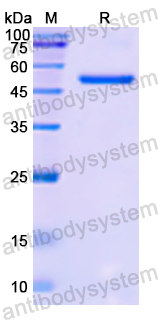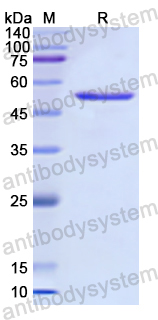Catalog No.
YHE71101
Expression system
E. coli
Species
Homo sapiens (Human)
Protein length
Ser1238-Lys1468
Predicted molecular weight
49.42 kDa
Nature
Recombinant
Endotoxin level
Please contact with the lab for this information.
Purity
>90% as determined by SDS-PAGE.
Accession
P49790
Applications
ELISA, Immunogen, SDS-PAGE, WB, Bioactivity testing in progress
Form
Lyophilized
Storage buffer
Lyophilized from a solution in PBS pH 7.4, 0.02% NLS, 1mM EDTA, 4% Trehalose, 1% Mannitol.
Reconstitution
Reconstitute in sterile water for a stock solution. A copy of datasheet will be provided with the products, please refer to it for details.
Shipping
In general, proteins are provided as lyophilized powder/frozen liquid. They are shipped out with dry ice/blue ice unless customers require otherwise.
Stability and Storage
Use a manual defrost freezer and avoid repeated freeze thaw cycles. Store at 2 to 8°C for frequent use. Store at -20 to -80°C for twelve months from the date of receipt.
Alternative Names
Nuclear pore complex protein Nup153, 153 kDa nucleoporin, Nucleoporin Nup153, NUP153
Investigating oncoprotein-mediated chromatin dysregulation in Drosophila melanogaster uncovers novel modifiers of the developmental impact of H3 K27M and EZHIP., PMID:40502002
The identification of a novel interaction site for the human immunodeficiency virus capsid on nucleoporin 153., PMID:40366356
Noncovalent Lasso Entanglements are Common in Experimentally Derived Intrinsically Disordered Protein Ensembles and Strongly Influenced by Protein Length and Charge., PMID:40317235
Structural and mechanistic bases for resistance of the M66I capsid variant to lenacapavir., PMID:40231850
Nuclear translocation of the LINE-1 encoded ORF1 protein alters nuclear envelope integrity in human neurons., PMID:40157412
Nup358 and Nup153 Facilitate nuclear import of BmNPV nucleocapsids in Bombyx mori cells., PMID:40120667
Novel Function of NUP153 in HNF4α Transcriptional Upregulation Contributes to Promoting HBV Replication., PMID:40014546
E3 ligase SYVN1-mediated polyubiquitination of CPSF6 promotes alternative polyadenylation and antivirus effects of macrophages., PMID:39951376
Structural insights into HIV-2 CA lattice formation and FG-pocket binding revealed by single-particle cryo-EM., PMID:39864060
The role of ABI2 in modulating nuclear proteins: Therapeutic implications for NUP54 and NUP153 in TNBC., PMID:39843146
Cul3 substrate adaptor SPOP targets Nup153 for degradation., PMID:39785820
The nucleoporin Nup153 is the anchor for Kif1a during basal nuclear migration in brain progenitor cells., PMID:39666457
Structural and Mechanistic Bases for Resistance of the M66I Capsid Variant to Lenacapavir., PMID:39651162
Coronavirus nucleocapsid protein enhances the binding of p-PKCα to RACK1: Implications for inhibition of nucleocytoplasmic trafficking and suppression of the innate immune response., PMID:39602452
Channel width modulates the permeability of DNA origami-based nuclear pore mimics., PMID:39536094
Identification of fibrosis-associated lncRNAs in diabetic cardiomyopathy patients., PMID:39475132
Structural insights into HIV-2 CA lattice formation and FG-pocket binding revealed by single particle cryo-EM., PMID:39416035
Nucleoporin 153 deficiency in adult neural stem cells defines a pathological protein-network signature and defective neurogenesis in a mouse model of AD., PMID:39227892
Nucleoporin Nup98 is an essential factor for ipo4 dependent protein import., PMID:38780165
Channel width modulates the permeability of DNA origami based nuclear pore mimics., PMID:38766144
Nup153 is not required for anchoring heterochromatic DSBs to the nuclear periphery., PMID:38737725
UBAP2L ensures homeostasis of nuclear pore complexes at the intact nuclear envelope., PMID:38652117
DNA double-strand break-capturing nuclear envelope tubules drive DNA repair., PMID:38632359
Exploring Cellular Gateways: Unraveling the Secrets of Disordered Proteins within Live Nuclear Pores., PMID:38260360
Nuclear pore pathology underlying multisystem proteinopathy type 3-related inclusion body myopathy., PMID:38158701
Human RTEL1 Interacts with KPNB1 (Importin β) and NUP153 and Connects Nuclear Import to Nuclear Envelope Stability in S-Phase., PMID:38132118
Spermatozoa in mice lacking the nucleoporin NUP210L show defects in head shape and motility but not in nuclear compaction or histone replacement., PMID:38129135
Super-enhancer trapping by the nuclear pore via intrinsically disordered regions of proteins in squamous cell carcinoma cells., PMID:37924814
Capsid-host interactions for HIV-1 ingress., PMID:37750702
Multidisciplinary studies with mutated HIV-1 capsid proteins reveal structural mechanisms of lattice stabilization., PMID:37699872
The HIV-1 capsid core is an opportunistic nuclear import receptor., PMID:37355754
Cul3 substrate adaptor SPOP targets Nup153 for degradation., PMID:37293018
Identification of New FG-Repeat Nucleoporins with Amyloid Properties., PMID:37239918
Sensitized piRNA reporter identifies multiple RNA processing factors involved in piRNA-mediated gene silencing., PMID:37210214
Two structural switches in HIV-1 capsid regulate capsid curvature and host factor binding., PMID:37040417
The capsid lattice engages a bipartite NUP153 motif to mediate nuclear entry of HIV-1 cores., PMID:36943880
Expression of the NUP153 and YWHAB genes from their canonical promoters and alternative promoters of the LINE-1 retrotransposon in the placenta of the first trimester of pregnancy., PMID:36923475
Crystallographic data of an importin-α3 dimer in which the two protomers are bridged by a bipartite nuclear localization signal., PMID:36875212
Modeling HIV-1 nuclear entry with nucleoporin-gated DNA-origami channels., PMID:36807645
Nuclear pore complexes concentrate on Actin/LINC/Lamin nuclear lines in response to mechanical stress in a SUN1 dependent manner., PMID:36619427
Evaluation of HIV-1 capsid genetic variability and lenacapavir (GS-6207) drug resistance-associated mutations according to viral clades among drug-naive individuals., PMID:36411257
Prion-like low complexity regions enable avid virus-host interactions during HIV-1 infection., PMID:36202818
Role of syndecan-4 in breast cancer pathophysiology., PMID:36094435
A role for Nup153 in nuclear assembly reveals differential requirements for targeting of nuclear envelope constituents., PMID:36044344
Defining the HIV Capsid Binding Site of Nucleoporin 153., PMID:36040047
Dynamic changes in O-GlcNAcylation regulate osteoclast differentiation and bone loss via nucleoporin 153., PMID:35879285
Spatiotemporal gating of Stat nuclear influx by Drosophila Npas4 in collective cell migration., PMID:35867785
Unraveling docking and initiation of mRNA export through the nuclear pore complex., PMID:35754154
SMARCC1 Enters the Nucleus via KPNA2 and Plays an Oncogenic Role in Bladder Cancer., PMID:35669562
Clade-Specific Alterations within the HIV-1 Capsid Protein with Implications for Nuclear Translocation., PMID:35625621


